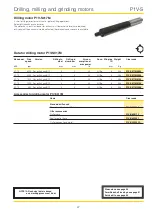
59
Stainless Steel Air Motors
P1V-S
Moving a component over a base, with friction
between them
The force required to move the component consists of two
parts - a frictional force to move the component over the base,
and an acceleration force
F
tot
= F
friction
+ F
acc
F
acc
= m x a
F
tot
= F
friction
+ m x a
F
tot
= the total force required in order to move the object in N
F
friction
= frictional force in N (either F
static
or F
kinetic
depending on
which is the greater force)
F
acc
= acceleration force in N
m = mass in kg
a = acceleration in m/s
A steel component weighing 500 kg is to be pulled over a dry
steel plate with an acceleration of 0,1 m/s
.
What is the total
force required to produce this movement?
F
tot
= F
kinetic
+ F
acc
F
tot
= F
kinetic
+ m x a
F
tot
= Fn x u + m x a
F
tot
= 500 x 9,81 x 0,15 + 500 x 0,1
F
tot
= 735,75 + 50
F
tot
= 785,75 N
Answer: A force of 780 N is required to produce this move-
ment.
F
n
F
friction
F
total
m
a
F
acc
F
kinetic resistance
a
m
F
n
F
F
F
acc
Moving a carriage over rails, with kinetic resistance
between them
The force required to move the component consists of two
parts - a kinetic resistance to move the component over the
base, and an acceleration force
F
tot
= F
kinetic resistance
+ F
acc
F
acc
= m x a
F
tot
= F
kinetic resistance
+ m x a
F
tot
= the total force required in order to move the object in N
F
kinetic resistance
= total kinetic resistance in N
F
acc
= acceleration force in N
m = mass in kg
a = acceleration in m/s
A carriage weighing 500 kg is to be pulled over steel rails
with an acceleration of 0, m/s
.
What is the total force required
to produce this movement?
F
tot
= F
kinetic resistance
+ F
acc
F
tot
= u
F
x F
N
+ m x a
F
tot
= 0,0030 x 500 x 9,81 + 500 x 0,
F
tot
= 6,1 + 500
F
tot
= 506 N
Answer: A force of 510 N is required to produce this move-
ment.
In practice
These calculations only produce values as they would be
under optimum conditions. There must be no inclines in either
direction. In applications using carriages, the rails must be
perfectly flat without any inclines, the wheels must be perfectly
round and there must be nothing on the rails (grains of sand,
etc.). There must also be no effects from wind, etc.
In addition, there is always uncertainty with regard to the
compressed air supply. How can we guarantee a pressure of
6 bar to the inlet port of the air motor?
Tip:
calculate the required theoretical values for the air motor
and assume a safety factor of 10 for the frictional force or
kinetic resistance, and add this to the acceleration force. If the
motor proves to be too powerful in practice, the supply air can
always be regulated by throttling or pressure regulation. If you
select a motor that is not powerful enough, on the other hand,
the only option is to replace it.
Содержание 1P1V-S020A00005
Страница 66: ...66 Stainless Steel Air Motors P1V S...
Страница 67: ......










































